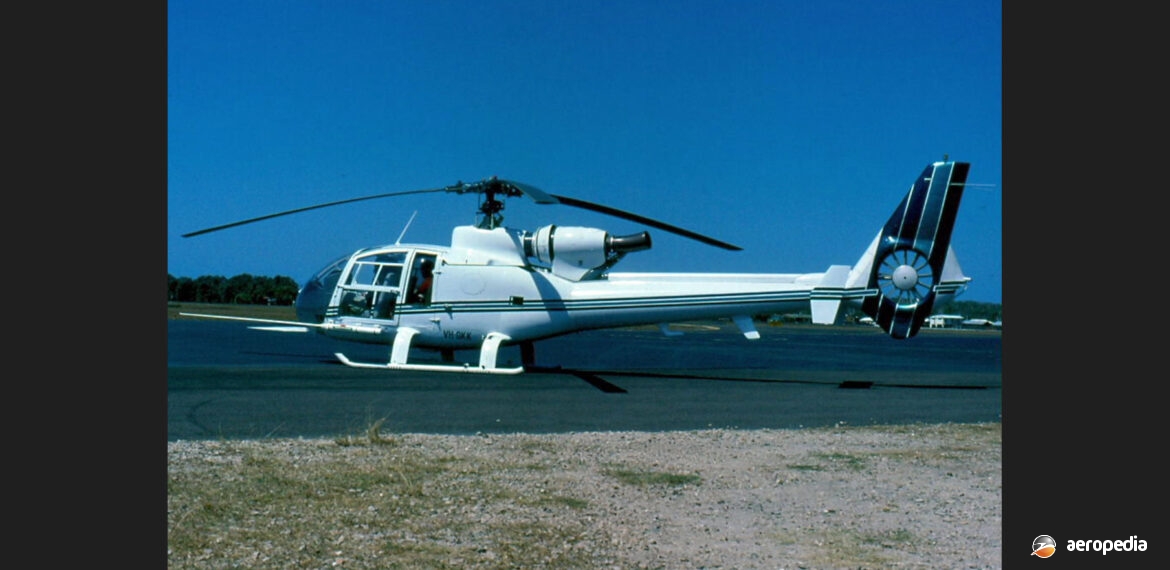Photograph:
Aerospatiale SA-341 Gazelle VH-GKK (c/n 1527) at Bankstown, NSW (David C Eyre)
Country of origin:
France
Description:
Five-seat general-purpose utility helicopter
Power Plant:
(SA-341G): One 440-kw (590-shp) Turbomeca Astazou IVA turboshaft
Specifications:
- Rotor diameter: 10.5 m (34 ft 5 ½ in)
- Fuselage length: 9.53 m (31 ft 3 ¼ in)
- Height: 3.15 m (10 ft 2 ½ in)
- Max cruising speed: 264 km/h (164 mph)
- Economical cruising speed: 233km/h (144 mph)
- Initial rate of climb: 540 m/min (1,770 ft/min)
- Hovering ceiling in ground effect: 2,850 m (9,450 ft)
- Range with typical load: 360 km (233 miles)
- Empty weight: 917 kg (2,022 lb)
- Loaded: 3,970 kg (8,800 lb)
History:
Developed as a general-purpose, light-weight helicopter for military and civil use, the Gazelle was produced in large quantities both by Aerospatiale in France and Westland in the United Kingdom, as well as being assembled in Yugoslavia. The prototype of the series, the SA-340, (F-WOFH) was flown for the first time on 7 April 1967 powered by a 269-kw (360-shp) Astazou II N2 turboshaft. The aircraft had an all-up weight of 1,451 kg (3,200 lb) and was demonstrated at the Paris Air Show that same year. The second prototype was flown for the first time on 12 April 1968 with an up-rated engine, a rigid rotor, fenestron tail-unit, and a T-tail.
Some difficulty was experienced during testing with the rigid rotor and a conventional semi-articulated rotor system was mounted on the prototype (c/n 001). The pre-production prototype (F-ZWRH) was designated SA-341. After comparative tests it was decided to fit production aircraft with a semi-articulated rotor-head. In July 1969 the aircraft was named the Gazelle and the third pre-production example (F-ZWRI c/n 03) became the British trials prototype and later XW276. Westland and Aerospatiale then offered a production licence to the Australian Government Aircraft Factory to produce the type for the Australian Army but Australia’s final order went to the Bell Kiowa.
Full scale production commenced and the Gazelle set two world records for helicopters in its class: the 3-km straight course record at 308.9 km/h (192 mph); and the 100-km closed circuit record at 294.45 km/h (183 mph). The first production aircraft was completed at Marignane France in July 1971 and was flown on 6 August 1971. It differed from the prototypes in having a longer cabin, a larger tail unit, an additional access door on the starboard side, and the 440-kw (590-shp) Astazou IIIA turboshaft.
A number of variants were developed and these included: SA-341A, original production aircraft; SA-341B for the British Army known as the AH1; SA-341C for the Royal Navy known as the HT2; SA-341D training variant for the RAF known as the HT3; SA-341E communications variant for the RAF known as the CC4; SA-341F, ALAT Army version for the UK; SA-341G for civil use; SA-341H military export variant; SA-342J civil variant with the Astazou XIVH engine with an extra 209-kw (280-shp); SA-342K military export variant; SA-342L civil variant with updated fenestron equipment; SA-342M military variant to carry four HOT missiles.
The SA-342 was released in 1980 and had the 649-kw (870-shp) Astazou XIVM engine and could carry four HOT missiles, AS-11 missiles or other weapons. A civil equivalent was the SA-342J which had a 100-kg (220 lb) increased payload.
Accommodation is normally for two in separate seats in the nose and a rear bench which could accommodate three, these seats being able to folded in order to carry cargo. First Gazelle in Australasia was an SA-341G (VH-WLS – c/n 1361) registered to the New South Wales National Parks and Wildlife Service in September 1976 but which, whilst carrying out a wallaby habitat survey near Bluff Mountain in the Warrumbungle National Park, encountered severe turbulence and lost power and crashed on 11 October 1981, being written off. It was replaced in 1982 by another Gazelle (VH-PWS – c/n 1293) but it was also damaged in an accident and written off at Mt Perisher on 13 December 1985.
In 1991 a further Gazelle arrived in 1991 for a private owner and this became VH-GKK³ (c/n 1527 – ex N9002Z, N9002A), the registration later being changed to VH-MZH on 14 July 1999, later again to VH-ONE5 on 25 August 1999; and VH-VAS on 6 May 2005. A further example became VH-OIW (c/n 1007 – ex G-ZELE, G-CBSA, XW845) on 6 October 2015, this being an ex British HT Mk 2 registered to Boomerang Aviation Pty Ltd of Mile End, SA. This company imported two further examples, both Mk Is, which became VH-OIZ (c/n 1682 – ex G-CHZF, XZ339) on 4 October 2017; and VH-OIX (c/n 1351 – ex C-CHYV, XX409) registered on 10 October 2017.
In 2001 – 2002 The Royal Air Force began retiring the type from service and they have been sold on the open market. A number have been obtained by private operators in New Zealand and have been converted for civil use. Those registered in New Zealand are Westland HT Mk 2s and include: ZK-HBH (c/n 1418 – ex XX441), ZK-HTB (c/n 1299 – ex XX391) and ZK-HTF (c/n 1436 – ex XX446). The last survivor of these three (ZK-HBH) was exported to South Africa in 2010.

